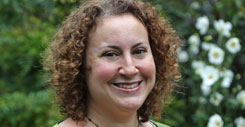
5 March 2018 – CISL’s Master’s in Interdisciplinary Design for the Built Environment (IDBE) delivers high-quality interdisciplinary part-time education for built environment professionals from around the world. For over 20 years, the IDBE has been instrumental in developing the skills that help individual professionals learn how to work better together. As the new IDBE course director, Kayla Friedman shares her passion for the built environment, her vision for achieving sustainable and resilient design and how she aims to contribute to the legacy of the course.
I have been involved with the IDBE in various capacities since 2011. As an architect and urban designer, doing a PhD at the University of Cambridge Engineering Department, I looked at issues related to planning and was immersed in interdisciplinary thinking. Prior to my studies I was an urban designer where all of my work involved bringing together the knowledge and expertise of various disciplines to design robust frameworks for future developments. This experience solidified for me the need for better interdisciplinary practice. Projects today are too complex, too nuanced for any one individual to be able to deeply understand or design all of the individual components. We need specialists who are able to better empathise, communicate, and contribute to the teams they are involved in to help realise a better vision of the future.
Sustainability and resilience
The future, and the role of the built environment in it, has also been rapidly elevated in importance throughout my career. When I was an undergraduate studying architecture at the University of Virginia sustainability was not high on the agenda until Bill McDonough joined the school of Architecture as Dean. He introduced us to the cradle-to-cradle concept, but it was still not mainstream. The next 20 years of my work in both the USA and the UK would highlight the rapid development in the industry’s awareness and knowledge of all of the ways that the construction and occupation of the built environment affects our planet and society. For those of us working in this time, it was an important and major influence. Sustainability and resilience have grown from a curiosity and a ‘good idea’ to a mandatory policy requirement in many parts of the world. The shift in society and industry has been fast and often exciting, but can also be confusing as it is still an evolving picture. Our education as professionals continues year on year, and will continue to do so for the foreseeable future. Not only because every year we understand more about the impacts of what we do, but alongside this understanding, there is also the introduction of new technologies and materials that continuously change the game.
Most professionals like myself, who trained in the 1990’s and early 2000’s, were not given this formal education in our professional courses. Now around the globe, sustainability and resilience are high on academic agendas across the built environment disciplines. Yet many mid-career professionals have had to learn on the job. This was the case with me. Suddenly ‘good design’ included things like Eco Homes (then the Code for Sustainable Homes, and now the improved Building Regulations), block and district heating, biodiversity provision, sustainable drainage systems and water management plans, car sharing schemes, cycle provision, home zones, and improved air quality just to name a few. To design, deliver, and ultimately operate successful projects, thoughtful and creative input was required from architects, engineers, consultants, owners, contractors, facility managers and occupiers. In my role as the urban designer on a number of estate regeneration projects in the UK, I saw how the teams that communicated well, and where all members were engaged, seemed to have the highest chance of delivering what was envisioned. Fractured teams or teams where there was a complete handover of the project along the design phases to different consultant teams often resulted in watered down and disappointing versions of the original vision.
Interdisciplinary practice
In the built environment, our jobs are often fast paced and demanding, leaving little time for study and assimilation; and, unfortunately, are jobs that are often done in silos. Multi-disciplinary teams are standard, but not many people know how to achieve true interdisciplinary practice, or why it is a good idea.
Decisions that are made early in a project during the schematic and design phases have significant impacts on the lifetime costs and impacts of a project. Although substantial costs are also incurred in the occupation phase of a project, many of these can also be anticipated and addressed in the design phases. Design as we look at it, is not just the remit of the architect. Every member who sits in on the design team, from the client to the consultants, is part of the design process. How much they engage with it, how they contribute to it, and the ownership they take of it all contributes to the final success and impacts of a project.
This ideal can only happen reliably when design team members are trained and prepared to work together in different ways from the industry norms. IDBE students tell us that the programme has helped them succeed professionally, and has improved their abilities to engage with and lead truly interdisciplinary teams. We focus the nebulous skills that tend to be overlooked in traditional professional education, like leadership, team working, and interdisciplinary practice. Skills that are critical to project success but not part of the standard professional curriculum. The explicit catalyst for this is that designing sustainable and resilient buildings and places requires thoughtful, creative, and progressive input from all of the disciplines. Personally, I do not view what we do as ‘sustainable design’. In fact, I may even sometimes question our segmentation of ‘interdisciplinary design’. Because what we strive to do here and to teach to our students is ‘good design’; because good design must by its nature be sustainable and resilient, and it must be robust and holistic and informed by all of the disciplines and stakeholders. When we finally achieve that understanding across all of our schools, disciplines, and industries, that’s when the IDBE will have completed its job.
The part-time IDBE Master’s is structured around emerging trends, opportunities, and challenges within the built environment including sustainability and resilience, health and well-being, energy, efficiency, conservation and heritage and stakeholder engagement. Find out more and apply here.





